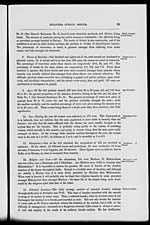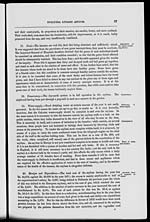Medicine - Mental health > 1867-1924 - Annual report of the insane asylums in Bengal > Insane asylums in Bengal annual reports 1867-1875 > Annual report on the insane asylums in Bengal for the year 1872
(548) Page 36
Download files
Individual page:
Thumbnail gallery: Grid view | List view

36 REPORT ON THE
Difficulties in the
management of
criminal lunatics.
enough to plan mischief, and the hardihood to carry it out. These, as a class, are lazy,
obstructive, and mischievous, through the force of bad example. Moreover, they are
difficult to deal with, because they are exempted from punishment and treated as ordinary
lunatics; and knowing this when they have become sane, they are not slow to avail themselves
of these privileges.
General manage-
ment.
14. Management.—The enforcement of regular habits, abundance of good food, fresh
air, and light occupation, are the remedial measures most trusted to for the restoration of the
inmates to sanity. The lunatics are mainly employed in wheat-grinding, rice-husking,
garden-work, and in the manufacture of various oils, such as castor, mustard, and cocoanut
oil; and in weaving. All the rice consumed by the inmates is husked within the walls.
They also make their own flour, weave and make their own personal clothing, blankets, and
bedding. The garden and other tools used in the asylum are repaired in the workshops of
the place, and all the vegetables required by the patients are grown in the asylum garden.
Psychological
peculiarities of na-
tives of India.
The native of India has, in his nature, far more of the intellectual than of the emotional.
The Negro, on the contrary, has more of the emotional than of the intellectual. In the
European, the two elements are more equally mixed. It is on this account, I think, that the
native when insane, rarely suffers from over-mastering delusions, and, as compared with
Europeans, is rarely very violent and furiously maniacal. His intellect being overthrown
with comparatively but little excitement, he subsides even in the earlier stages of the disease
into a state characterized in the records as dull and stupid. Unmoved by the intensity of
the feelings, which, when their reason has lost its control, often leads Europeans to believe
themselves to be the great prophets, founders of religion, and conquerors of history: he at
the very beginning of his insanity falls into a condition of intellectual prostration, which
closely resembles the dementia of Europe.
Difficulty of de-
tecting cure.
Wanting, therefore, in intellectual and emotional intensity, and in consequence being less
demonstrative than European insanes, it is not always apparent at what period an insane
native becomes sane. Seen day by day through the long period over which his cure may
extend, the progress of his cure is not always discernible unless carefully and specially
looked for. In this way it is possible that a native lunatic may slip into health unnoticed,
and if not strictly examined, (for from the very quiescence of his nature he is not given to
assert himself), he may, unknown to his superintendent, remain cured amongst the uncured.
To guard against such an oversight, an excellent practice was long ago adopted at Dullunda.
It is this, once a month each patient is passed through the office and his mental condition at
the time rigidly examined.
Restraint.
15. Restraint.—Restraint has been had recourse to in the year perhaps a little too freely.
The methods hitherto adopted have been ligatures and woollen bags. It is now proposed to
stop the use of these almost entirely, and to adopt seclusion in a room, specially prepared for
the purpose, instead. Every inmate who may thus be secluded, will be taken out morning
and evening for fresh air and exercise.
Capacity of build-
ings.
Overcrowding.
16. Buildings.—The superficial area of the dormitories has recently been measured, and,
allowing 50 superficial feet to each inmate, it is found that the asylum has accommodation
for a population of 293. The male wards can accommodate 246, and the female wards, 47.
In the year under review, the largest number of male residents at Dullunda at one time
was 305, and of females, 88; while the average number resident throughout the year was of
males 276 and females 78 ; and at no time did the numbers, male and female combined, ever
fall below 319. From these figures it is apparent that the overcrowding throughout the year
was steady and continued, and at times excessive. The females are specially badly off in
respect of space, inasmuch as they are more crowded in their sleeping rooms than the men,
Set display mode to: Large image | Zoom image | Transcription
Images and transcriptions on this page, including medium image downloads, may be used under the Creative Commons Attribution 4.0 International Licence unless otherwise stated. ![]()
| Permanent URL | https://digital.nls.uk/83379644 |
|---|




